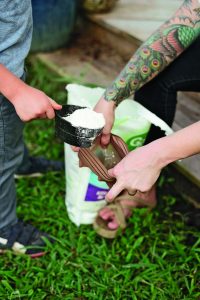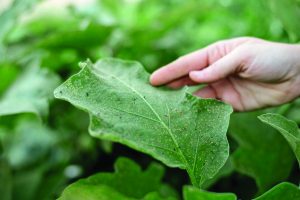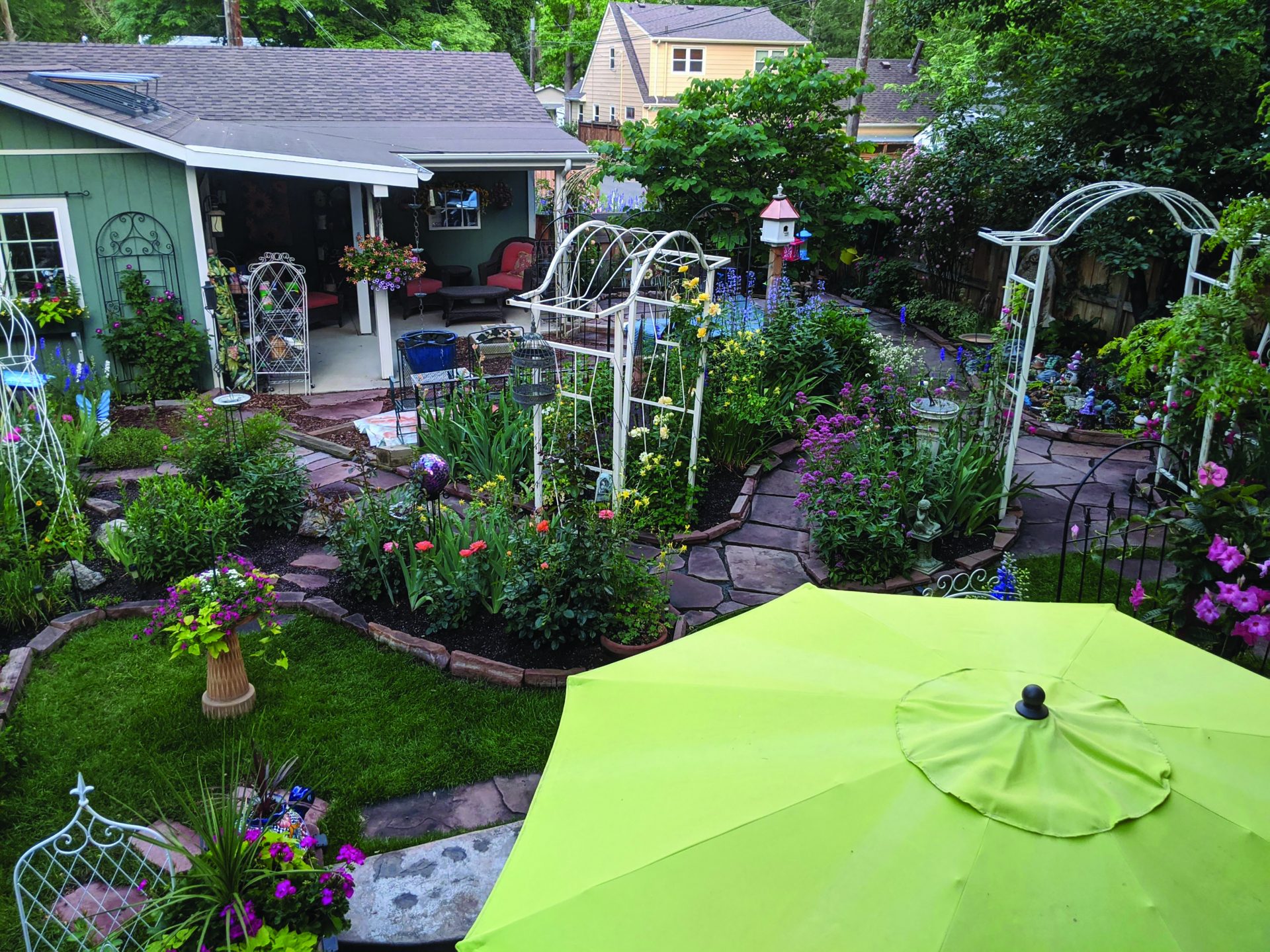Organic Solutions for Pest Peeves
11 Jun 2021
Follow these tips to help rid your garden of vegetable pests.
Story by Jessica Sowards Photos by Makenzie Evans Photography
During the pandemic, many of us turned to gardening for stress relief and growing our own food. Novice gardeners probably experienced some notable successes (zucchini!) and some demoralizing failures (pests!). Fortunately, organic solutions are available to help you manage garden invaders. Here are a few organic pesticides and instructions to create your own from (Cool Springs Press).
Diatomaceous Earth
Diatomaceous earth, also known as DE, is the fossilized remains of hard-shelled organisms called diatoms. DE comes in the form of a white powder and is one of the more popular forms of natural pest control. It kills hard-shelled insects by destroying the outer layer of their exoskeletons, causing them to dehydrate rapidly. It also dehydrates soft-bodied insects. In order to be an effective pesticide, DE must be food grade and can be purchased at feed stores or wherever gardening products are sold.
Apply a light to medium dusting on plants where pests are present. Avoid dusting flowers, because DE can affect pollinators. Apply in the evening and reapply after rain. Wear face protection—DE is just as abrasive to our lungs as it is to insect exoskeletons.


Insecticidal Soap
Insecticidal soap is an effective, economical solution that’s been a common staple in the organic pest-control arsenal for generations. In short, soap dries insects out. It works on contact by disrupting their cell walls, causing them to dehydrate and die. For hundreds of years, gardeners repurposed their soapy dishwater by applying it to the garden, which was right outside the kitchen door. These days, you can purchase concentrated insecticidal soaps without additives for the purpose of pest control. You can also use liquid castile soaps with no added detergents or perfumes to the same effect.
Soap is often mixed with oil (which suffocates insects) to create a homemade pest remedy. Soap does not have a residual effect when sprayed on foliage, and must be sprayed directly on insects to be effective.
Effective on, but not limited to, aphids, thrips, mites, mealybugs and Japanese beetles.
Homemade Natural Garden Pest Spray
Use this spray on the garden the same day as mixing. Spray in the evening to avoid sunscald on foliage. Coat the tops and bottoms of leaves where pest infestation is evident, coating any visible insects. Reapply daily until population notably decreases.
INGREDIENTS
1?cup (237 ml) vegetable oil 1 tablespoon (15 ml) liquid -castile soap 5–20?drops of peppermint essential oil
Mix ingredients together in a mason jar. Dilute 1 tablespoon (15 ml) of this mixture per quart (946 ml) of water.
Bacillus Thuringiensis
Also known as Bt, bacillus thuringiensis is a naturally occurring bacteria found in soil that, when consumed by insects in the larval stage, causes them to sicken and die. Bt is effective against larvae, but it must be applied while they are feeding. Early morning and evening is when they most actively feed. Avoid spraying in the heat of the day because the insect larvae will be least active then.


Pest eggs are usually laid on the underside of foliage, so monitor these closely for egg clusters or very newly hatched larvae. Very young caterpillars do minimal damage to plants, barely eating into the surface of the leaves. However, once they mature, they can destroy an entire plant in a couple of short days. Apply Bt spray on the leaves all around larvae as soon as you find them. Reapply daily until the infestation decreases, and then reapply every few days. Always reapply after rain. Since Bt only affects larvae, you do not have to be concerned about damage to birds, earthworms or honeybees.
Note: Bt is living bacteria, so the water you mix the concentrate with matters. Very hard water is alkaline and can kill the bacteria, rendering Bt useless for pest control. If you have an issue with hard water, mix Bt with distilled water instead.
Effective on any insect in the larval stage including, but not limited to, hornworms, borers and cabbage loopers.
Gardener and Garden Care
During the summer months, it’s best to do garden chores in the early morning or late evening. The heat of the day is hard on gardeners and gardens. Pruning and handling plants when they are heat stressed isn’t good for them, and working in full sun and extreme heat raises the risk of heatstroke for you. Protect your skin from the sun, stay hydrated and do chores during the times of day when it is easiest on the body. This makes garden maintenance far more sustainable!
Homemade Baking Soda Remedy
This homemade spray is effective against powdery mildew, early blight, or any other mildew-type fungal infections. For best results, prune excess foliage and then spray what remains. The earlier you treat the issue, the greater your chance of eliminating it. Baking soda creates an alkaline environment on the leaves, hindering the growth of fungus.
 INGREDIENTS
INGREDIENTS
1 gallon (3.8 liters) water 3 tablespoons (25 grams) baking soda 1 tablespoon (15 ml) neem oil* or vegetable oil A few drops of dish soap to help emulsify
Mix ingredients together and spray on tops and bottoms of leaves. Apply in the evening so oil doesn’t scald foliage in the sun. Reapply daily.
*Neem oil yields better results than vegetable oil.
Pyrethrin
Pyrethrin, also called pyrethrum, is a naturally occurring chemical compound derived from dried and crushed chrysanthemum flowers. When applied directly to insects, pyrethrin affects their nervous systems and kills them almost immediately. It is nondiscriminatory in the insects it kills and will also eliminate ladybugs, honeybees and other beneficial insects. Therefore, never broadcast it over the entire garden. Rather, spray it directly on pests that you can see. It breaks down very quickly (within two days), so it is not used as a preventive.

Because of its direct effect to end currently existing pests (unlike other pest controls, which need to be consumed by the pest), pyrethrin is a good option for active infestations or if you miss a pest in its earlier stages. However, because it can damage beneficial insects, it should not be overused. Mix according to instructions and apply directly to outbreaks.
Note: You may come across a product called permethrin. This carries a similar name, but it’s the synthetic version of naturally occurring pyrethrin. It’s commonly used in lice treatments and mosquito sprays. Permethrin is not approved for organic gardening and, if applied to your garden, will continue existing in the environment for 30 to 90 days. It is highly toxic to aquatic life.
Effective on, but not limited to, cucumber beetles, squash bugs, stink bugs, leafhoppers and cabbage loopers.
Neem Oil
Neem oil is cold-pressed from the seeds of neem trees, which are native to India and South Asia. It’s important to purchase 100% cold-pressed neem oil, as oil that is diluted with additives or extracted by other methods won’t be as effective for pest control. The active components of neem oil work as repellents and suppressants. They discourage insects from feeding on plants, and if insects do feed on neem-covered plants, their ability to feed is hindered, their growth is stunted, and their mating patterns are interrupted. When growth is stunted in the larval stage, the insects are effectively deterred from further damaging plants. The idea of repeated exposure to neem is not just to kill the pests -currently on your plants, but also to interrupt their life cycles. So you will see reduced pest numbers as you continue to regularly apply.

Mix oil as directed on the product instructions. Adding a tablespoon (15 ml) of liquid castile soap per gallon (3.8 liters) of mixed spray helps the oil emulsify in water, creating a more even application. Neem oil should be applied only in the very early morning or, more preferably, in the evening. Think of it as tanning oil: If you put it on your plants in the middle of a sunny day, they will end up with sunburn! It must be reapplied every couple of days to effectively interrupt insect life cycles, and must be reapplied after rain.
Effective on chewing and sucking insects, such as aphids, mealybugs and whiteflies.

Jessica Sowards is the author of “The First-Time Gardener: Growing Vegetables” (Cool Springs Press). She shares her gardening journey on social media and is raising six children with her husband on a small homestead called Roots and Refuge Farm.












